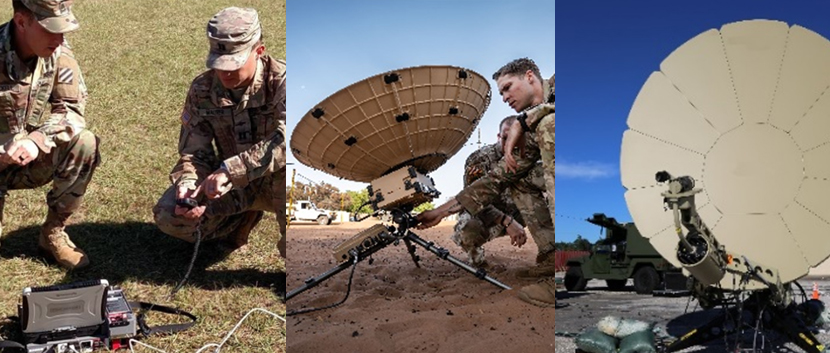
The Army’s flexible, modular, scalable and tailorable Satellite Communication (SATCOM) Family of Terminals provide an optimal variety of expeditionary, mobile satellite terminals to units worldwide to best support different formations, echelons, mission requirements and locations.
These SATCOM systems provide global voice and data network communications, and the exchange of time-sensitive situational awareness, intelligence, and mission command information, while at-the-quick-halt, during all operational phases, echelons and missions -- from initial entry at the tactical edge to more mature long-standing operations. The expeditionary quick set-up easy-to-use systems facilitate the fusion of maneuver, fires, intelligence and sustainment information at the front edge of the battlefield and remote locations.
The commercial Family of SATCOM Terminals supports Command Post mobility and survivability by providing several easy-to-deploy, quick-set up/tear down communications solutions to enable units to relocate rapidly, while delivering critical real-time battlefield situational awareness to keep forces safe and ensure mission success.
In support of the Army’s network goals to support Large Scale Combat Operations, the service is leveraging the Family of Terminals (FoT) acquisition strategy to support its expeditionary SATCOM needs. This strategy allows for procurement of the most capable and formation appropriate terminals to best suit requirements. The Army plans to further consolidate the current variety of ground satellite equipment in its portfolio, leveraging the more versatile “family of systems” approach, while retaining the acquisition flexibility to insert new technologies as they evolve. The strategy is expected to realize substantial cost savings and avoidance, while delivering the right array of solutions to enable the needed operational flexibility, signal path diversity, and enhanced capability to support multi-domain operations, while easing sustainability and training burdens. It enables more tailorable material solution delivery to the field with the right capability to be equipped at the required echelon.
The Army’s future SATCOM portfolio is expected to include emerging commercial high-throughput, low latency (HT/LL) network transport, such as Low Earth Orbit (LEO) and Medium Earth Orbit (MEO) and advanced high-throughput Geosynchronous Earth Orbit (GEO) SATCOM. Underpinning the Army’s efforts to increase network capability, capacity and resiliency is the need to increase simplicity at the edge, since more and more Soldiers fighting there will be general purpose users who are not signal trained. One solution currently in development, the Next Generation Tactical Terminal (NGTT), will simultaneously leverage emerging HT/LL LEO and MEO constellation providers and current and future GEO constellations, as well as multiple frequency bands, with a single terminal.
FY2025 Current Systems
Currently, PdM SATCOM manages a Suite of SATCOM Terminals (SoT) within the Army’s larger Family of SATCOM Terminals (FoT) portfolio
Extra Small SATCOM Terminals
- SoT - Global Rapid Response Information Package (GRRIP) and modernized T2C2-Ultra Lite: [Integrated antenna]. The GRRIP and T2C2-Ultra Lite provide highly transportable initial entry capability and situational awareness in air-to-land missions, enabling Soldiers to stay connected and informed. These extra small terminals can also support special small team elements that require network connectivity in austere environments.
- Fits into a single handheld airline carry-on transit case for rapid mobility and force scalability
- Sets up and connects in minutes
- Utilizes L-Band
- Supports multiple security and mission enclaves
Small SATCOM Terminals:
- SoT - SCOUT-Small (0.65m/0.95m):
- Transportable in three hard side transit cases
- Supports 12 users over multiple enclaves
- Airline checkable for commercial transport
- Rapidly setup by two Soldiers
- Tri-band capable (X, Ku, & Ka)
Medium SATCOM Terminals:
- SoT - T2C2 Lite [1.2m Inflatable Satellite Antenna (ISA) and T2C2 Lite v2 (1.3m ISA)]:
- Transportable in five hard side transit cases, or two soft cases plus one ancillary
- Supports six users over multiple enclaves
- Airline checkable for commercial transport
- Rapidly setup by two Soldiers
- Tri-band capable (X, Ku, & Ka)
- SoT - SCOUT-Medium (1.3M):
- Transportable in four hard side transit cases
- Supports 48 users over two enclaves
- Airline checkable for commercial transport
- Rapidly setup by two Soldiers
- Tri-band capable (X, Ku, & Ka)
- Scalable Network Node (SNN is managed by PdM Mission Network)
- Sustainment Transport System SATCOM (STS SATCOM is managed by PdM UNCI)
Large SATCOM Terminals:
- SoT - T2C2 Heavy (2.4m ISA):
- Transportable in seven hard side transit cases
- Supports 48 users over multiple enclaves
- Airline checkable for rapid commercial transport
- Quick setup by two Soldiers
- Tri-band capable (X, Ku, & Ka)
- Used by brigades, divisions and corps
- In the future, FoT-Large will support the Large Deployable Terminal (LDT) that will replace the current Satellite Transportable Terminal (STT) (managed by PdM Mission Network).
- In the future, FoT-Large will also support the Phoenix Terminal Program.
Extra Large SATCOM Terminals:
- The Extra Large Deployable Terminal (XLDT) will replace the current Tactical Hub Node (TCN) managed by PdM Mission Network, with the next generation enhanced THN to be known as
- Deployable Ku/Ka/X-band Earth Terminals (DKETs), managed by the Commercial Satellite Terminals Program, also serve as one of the extra-large terminals in Project Manager Tactical Network’s Family of Satellite Communications (SATCOM) Terminals portfolio.